Evaluation of Eight Global Precipitation Datasets in Hydrological Modeling
Abstract
:1. Introduction
2. Datasets
2.1. Global Precipitation Datasets
2.2. Other Meteorological Datasets
2.3. Observed Streamflow
3. Methods
- (1)
- PPs evaluation was conducted by comparison with the rain gauge observations over the selected catchments. In addition, we applied a bias correction method to PPs and obtained “bias corrected-PPs” (BC-PPs), which were also conducted in the comparison.
- (2)
- The hydrological model calibration was firstly performed driven by rain gauge observations, and the calibrated parameter set was referred to as the ‘‘Reference Parameter-sets’’ (RP). The performance of hydrological model calibration served as a benchmark value for later hydrological modeling driving by the eight PPs.
- (3)
- The performances of hydrological modeling with the PPs were evaluated in the following three steps: in step 1, the reliability of PPs for hydrological modeling was investigated by running the model with RP in the calibration period; in step 2, a hydrological model was calibrated by each PPs, which was called PPs-specific calibration, and then their performances were compared with the benchmark value; in step 3, the BC-PPs were used to drive the hydrological model based on the RP in the calibration period and their performances were compared with the benchmark value.
3.1. XAJ Model
3.2. Bias Correction Method
- (1).
- The LOCI method was used to correct the precipitation occurrence, which ensured that the frequency of the precipitation occurrence estimated by PPs equaled to that of the observed data for a specific month.
- (2).
- The DT method was then used to correct the empirical distribution of PPs-estimated precipitation magnitudes in terms of 100 quantiles from 0.01 to 1 with an interval of 0.01.
3.3. Performance Evaluation Indices
- (1)
- The Pearson linear correlation coefficient (R) is used to assess the agreement between 3-day means of PPs and gauge-observed precipitation as follows:where and are the 3-day mean PPs and gauge-observed precipitation time series, respectively. and are the average of all the 3-day means of PPs and gauge-observed precipitation, respectively. is the length of 3-day mean time series. The R ranges from − to 1 and a larger R represents a better performance. Note that the R is calculated for 3-day mean rather than daily precipitation estimates, as Beck and Vergopolan [26] did, which is done to reduce the impact of the issue with gauge reporting times (i.e., the start and end times of the daily accumulations).
- (2)
- The relative bias ratio (RB) is used to assess the systematic bias of precipitation estimates of PPs and it is also used to assess the systematic bias of the simulated discharge as follows:where and are the daily values of the ith day for the gauge-observed precipitation and the PPs, respectively. and are the average of all the daily values for the gauge-observed precipitation and the PPs, respectively. is the number of days. The RB ranges from - to and the best result is 0.
- (3)
- The root mean square error (RMSE) is used to assess the difference between PPs and gauge-observed precipitation as follows:The RMSE ranges from 0 to and a smaller RMSE represents a better performance.
4. Results and Discussion
4.1. Evaluation of Precipitation Estimates
4.2. Evaluation of Hydrological Modeling
4.2.1. Benchmark Performance of Streamflow Simulation with Gauge-Observed Precipitation
4.2.2. Evaluation of Streamflow Simulations with Eight PPs
5. Conclusions
- (1)
- Compared with the gauge-observed precipitation, GPCC provides the best performance overall, followed by MSWEP V2.0, which is merged based on multiple satellite and reanalysis datasets.
- (2)
- Among all the PPs, MSWEP V2.0 and CMORPH BLD, which incorporate daily gauge data provide superior hydrological performance, followed by those incorporating 5-day (CHIRPS V2.0) and monthly (TMPA 3B42RT, WFDEI, and PERSIANN CDR) gauge data. MSWEP V2.0 and CMORPH BLD perform better than GPCC, underscoring the effectiveness of merging multiple satellite and reanalysis datasets.
- (3)
- Regionally, all PPs exhibit better performances in temperate regions than in arid or topographically complex mountainous regions, due to the sparse rain-gauge networks and the highly non-linear rainfall-runoff response. Uncertainty exists in the regional performances of all the PPs.
- (4)
- PPs-specific calibration and bias correction both can improve the streamflow simulations for all eight PPs in terms of the Nash and Sutcliffe efficiency and the absolute bias. The improvements in hydrological modeling performances are larger for the PPs with poor performances.
Author Contributions
Funding
Acknowledgments
Conflicts of Interest
Appendix A
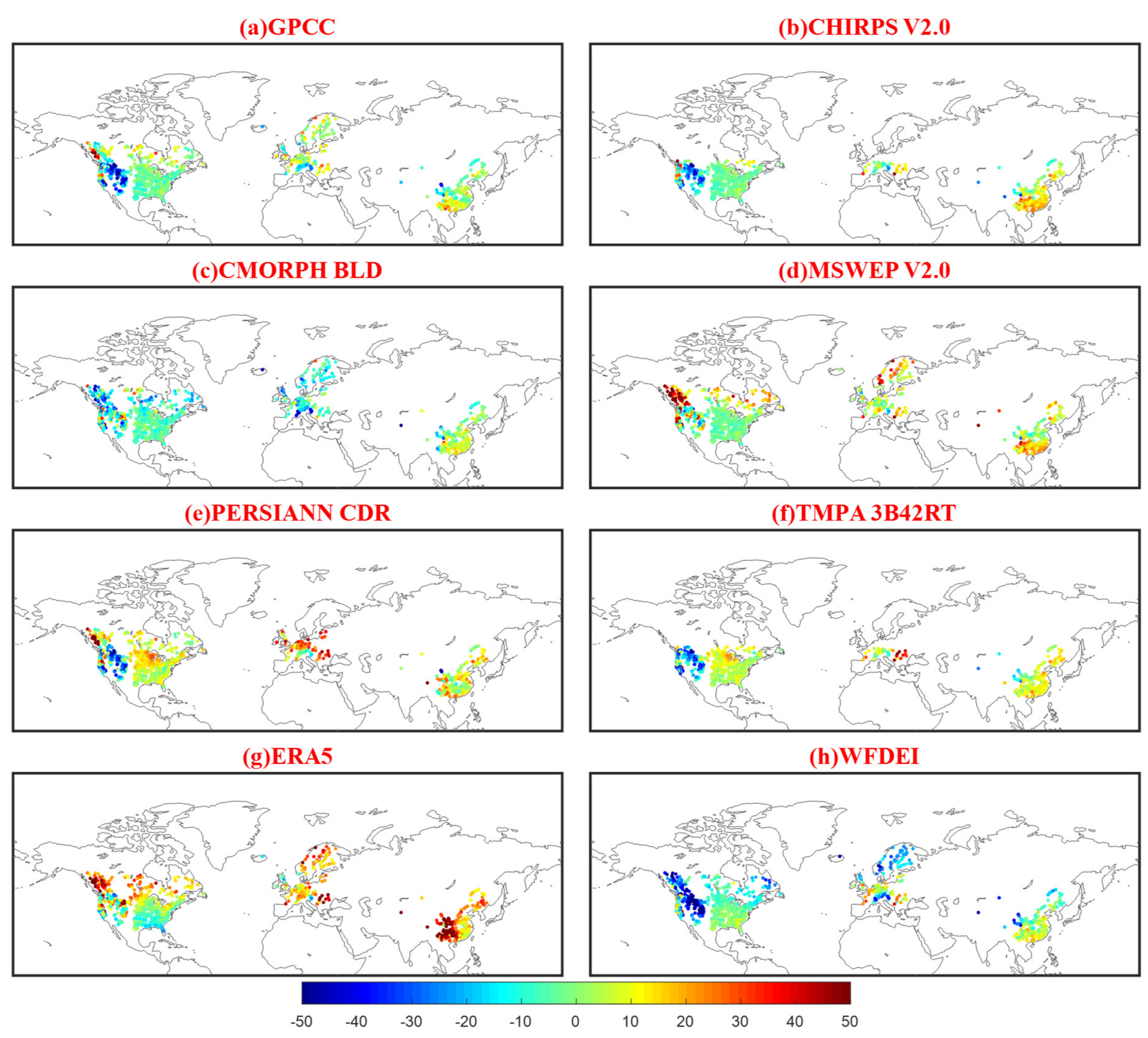
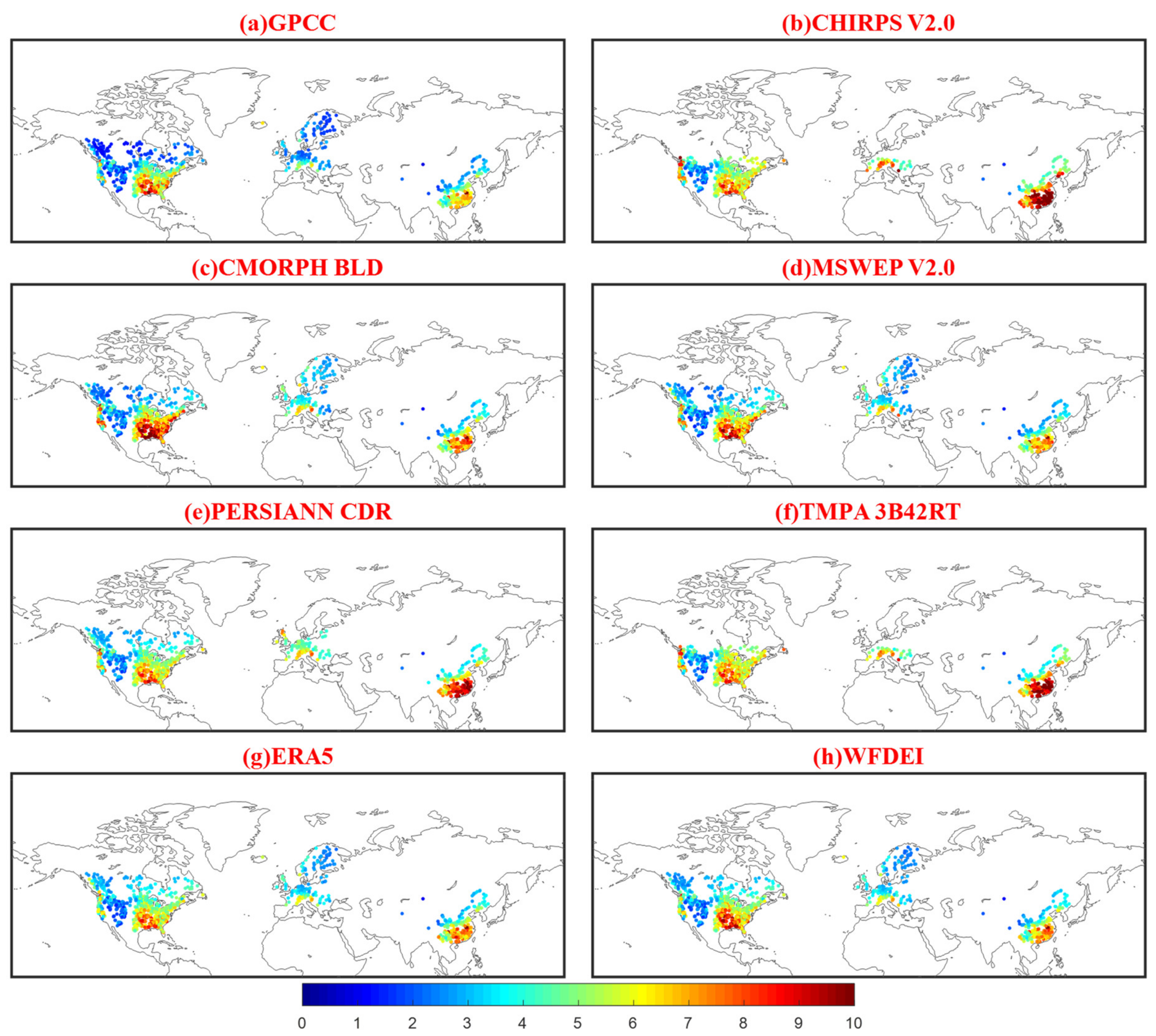
References
- Trenberth, K.E.; Dai, A.; Rasmussen, R.M.; Parsons, D.B. The Changing Character of Precipitation. Bull. Am. Meteorol. Soc. 2003, 84, 1205–1218. [Google Scholar] [CrossRef]
- Eltahir, E.A.B.; Bras, R.L. Precipitation recycling. Rev. Geophys. 1996, 34, 367–378. [Google Scholar] [CrossRef]
- Hou, A.Y.; Kakar, R.K.; Neeck, S.; Azarbarzin, A.A.; Kummerow, C.D.; Kojima, M.; Oki, R.; Nakamura, K.; Iguchi, T. The global precipitation measurement mission. Bull. Am. Meteorol. Soc. 2014, 95, 701–722. [Google Scholar] [CrossRef]
- Kidd, C.; Huffman, G. Global precipitation measurement. Meteorol. Appl. 2011, 18, 334–353. [Google Scholar] [CrossRef]
- Larson, L.W.; Peck, E.L. Accuracy of precipitation measurements for hydrologic modeling. Water Resour. Res. 1974, 10, 857–863. [Google Scholar] [CrossRef]
- Maggioni, V.; Meyers, P.C.; Robinson, M.D. A Review of Merged High-Resolution Satellite Precipitation Product Accuracy during the Tropical Rainfall Measuring Mission (TRMM) Era. J. Hydrometeorol. 2016, 17, 1101–1117. [Google Scholar] [CrossRef]
- Sun, Q.; Miao, C.; Duan, Q.; Ashouri, H.; Sorooshian, S.; Hsu, K.L. A review of global precipitation data sets: Data sources, estimation, and intercomparisons. Rev. Geophys. 2018, 56, 79–107. [Google Scholar] [CrossRef] [Green Version]
- Alijanian, M.; Rakhshandehroo, G.; Mishra, A.K.; Dehghani, M. Evaluation of satellite rainfall climatology using CMORPH, PERSIANN-CDR, PERSIANN, TRMM, MSWEP over Iran. Int. J. Clim. 2017, 37, 4896–4914. [Google Scholar] [CrossRef]
- Buarque, D.C.; Paiva, R.; Clarke, R.T.; Mendes, C.A.B. A comparison of Amazon rainfall characteristics derived from TRMM, CMORPH and the Brazilian national rain gauge network. J. Geophys. Res. Space Phys. 2011, 116. [Google Scholar] [CrossRef]
- Bumke, K.; König-Langlo, G.; Kinzel, J.; Schröder, M. HOAPS and ERA-Interim precipitation over the sea: Validation against shipboard in situ measurements. Atmos. Meas. Tech. 2016, 9, 2409–2423. [Google Scholar] [CrossRef] [Green Version]
- Hirpa, F.A.; Gebremichael, M.; Hopson, T. Evaluation of High-Resolution Satellite Precipitation Products over Very Complex Terrain in Ethiopia. J. Appl. Meteorol. Clim. 2010, 49, 1044–1051. [Google Scholar] [CrossRef]
- AghaKouchak, A.; Behrangi, A.; Sorooshian, S.; Hsu, K.; Amitai, E. Evaluation of satellite-retrieved extreme precipitation rates across the central United States. J. Geophys. Res. Space Phys. 2011, 116. [Google Scholar] [CrossRef]
- Islam, T.; Rico-Ramirez, M.A.; Han, D.; Srivastava, P.K.; Ishak, A.M. Performance evaluation of the TRMM precipitation estimation using ground-based radars from the GPM validation network. J. Atmos. Sol. Terr. Phys. 2012, 77, 194–208. [Google Scholar] [CrossRef]
- Bosilovich, M.G.; Chen, J.; Robertson, F.R.; Adler, R.F. Evaluation of Global Precipitation in Reanalyses. J. Appl. Meteorol. Clim. 2008, 47, 2279–2299. [Google Scholar] [CrossRef]
- Kalnay, E.; Kanamitsu, M.; Kistler, R.; Collins, W.; Deaven, D.; Gandin, L.; Iredell, M.; Saha, S.; White, G.; Woollen, J.; et al. The NCEP/NCAR 40-year reanalysis project. Bull. Am. Meteorol. Soc. 1996, 77, 437–472. [Google Scholar] [CrossRef] [Green Version]
- Uppala, S.M.; Kållberg, P.W.; Simmons, A.J.; Andrae, U.; Bechtold VD, C.; Fiorino, M.; Gibson, J.K.; Haseler, J.; Hernandez, A.; Kelly, G.A.; et al. The ERA-40 re-analysis. Q. J. R. Meteorol. Soc. A J. Atmos. Sci. Appl. Meteorol. Phys. Oceanogr. 2005, 131, 2961–3012. [Google Scholar] [CrossRef]
- Onogi, K.; Tsutsui, J.; Koide, H.; Sakamoto, M.; Kobayashi, S.; Hatsushika, H.; Matsumoto, T.; Yamazaki, N.; Kamahori, H.; Takahashi, K.; et al. The JRA-25 Reanalysis. J. Meteorol. Soc. Jpn. 2007, 85, 369–432. [Google Scholar] [CrossRef] [Green Version]
- Beck, H.E.; Pan, M.; Roy, T.; Weedon, G.P.; Pappenberger, F.; Van Dijk, A.I.; Huffman, G.J.; Adler, R.F.; Wood, E.F. Daily evaluation of 26 precipitation datasets using Stage-IV gauge-radar data for the CONUS. Hydrol. Earth Syst. Sci. 2019, 23, 207–224. [Google Scholar] [CrossRef] [Green Version]
- Beck, H.E.; Van Dijk, A.I.J.M.; Levizzani, V.; Schellekens, J.; Miralles, D.; Martens, B.; De Roo, A. MSWEP: 3-hourly 0.25° global gridded precipitation (1979–2015) by merging gauge, satellite, and reanalysis data. Hydrol. Earth Syst. Sci. 2017, 21, 589–615. [Google Scholar] [CrossRef] [Green Version]
- Hersbach, H.; Bell, B.; Berrisford, P.; Hirahara, S.; Horanyi, A.; Muñoz-Sabater, J.; Nicolas, J.; Peubey, C.; Radu, R.; Schepers, D.; et al. The ERA5 global reanalysis. Q. J. R. Meteorol. Soc. 2020, 146, 1999–2049. [Google Scholar] [CrossRef]
- Behrangi, A.; Khakbaz, B.; Jaw, T.C.; AghaKouchak, A.; Hsu, K.; Sorooshian, S. Hydrologic evaluation of satellite precipitation products over a mid-size basin. J. Hydrol. 2011, 397, 225–237. [Google Scholar] [CrossRef] [Green Version]
- Bitew, M.M.; Gebremichael, M.; Ghebremichael, L.T.; Bayissa, Y.A. Evaluation of high-resolution satellite rainfall products through streamflow simulation in a hydrological modeling of a small mountainous watershed in Ethiopia. J. Hydrometeorol. 2012, 13, 338–350. [Google Scholar] [CrossRef]
- Collischonn, B.; Collischonn, W.; Tucci, C.E.M. Daily hydrological modeling in the Amazon basin using TRMM rainfall estimates. J. Hydrol. 2008, 360, 207–216. [Google Scholar] [CrossRef]
- Li, X.; Chen, Y.; Deng, X.; Zhang, Y.; Chen, L. Evaluation and Hydrological Utility of the GPM IMERG Precipitation Products over the Xinfengjiang River Reservoir Basin, China. Remote. Sens. 2021, 13, 866. [Google Scholar] [CrossRef]
- Huffman, G.J.; Bolvin, D.T.; Nelkin, E.J. Integrated Multi-satellitE Retrievals for GPM (IMERG) technical documentation. Nasa/Gsfc Code 2015, 612, 2019. [Google Scholar]
- Beck, H.E.; Vergopolan, N.; Pan, M.; Levizzani, V.; Van Dijk, A.I.J.M.; Weedon, G.P.; Brocca, L.; Pappenberger, F.; Huffman, G.J.; Wood, E.F. Global-scale evaluation of 22 precipitation datasets using gauge observations and hydrological modeling. Hydrol. Earth Syst. Sci. 2017, 21, 6201–6217. [Google Scholar] [CrossRef] [Green Version]
- Camici, S.; Ciabatta, L.; Massari, C.; Brocca, L. How reliable are satellite precipitation estimates for driving hydrological models: A verification study over the Mediterranean area. J. Hydrol. 2018, 563, 950–961. [Google Scholar] [CrossRef]
- Yilmaz, K.K.; Hogue, T.S.; Hsu, K.-L.; Sorooshian, S.; Gupta, H.; Wagener, T. Intercomparison of Rain Gauge, Radar, and Satellite-Based Precipitation Estimates with Emphasis on Hydrologic Forecasting. J. Hydrometeorol. 2005, 6, 497–517. [Google Scholar] [CrossRef]
- Mei, Y.; Anagnostou, E.N.; Nikolopoulos, E.; Borga, M. Error Analysis of Satellite Precipitation Products in Mountainous Basins. J. Hydrometeorol. 2014, 15, 1778–1793. [Google Scholar] [CrossRef]
- Qi, W.; Zhang, C.; Fu, G.; Sweetapple, C.; Zhou, H. Evaluation of global fine-resolution precipitation products and their uncertainty quantification in ensemble discharge simulations. Hydrol. Earth Syst. Sci. 2016, 20, 903–920. [Google Scholar] [CrossRef] [Green Version]
- Hughes, D.A. Comparison of satellite rainfall data with observations from gauging station networks. J. Hydrol. 2006, 327, 399–410. [Google Scholar] [CrossRef]
- Ciabatta, L.; Brocca, L.; Massari, C.; Moramarco, T.; Gabellani, S.; Puca, S.; Wagner, W. Rainfall-runoff modelling by using SM2RAIN-derived and state-of-the-art satellite rainfall products over Italy. Int. J. Appl. Earth Obs. Geoinf. 2016, 48, 163–173. [Google Scholar] [CrossRef]
- Huffman, G.J.; Bolvin, D.T.; Nelkin, E.J.; Wolff, D.B.; Adler, R.F.; Gu, G.; Hong, Y.; Bowman, K.P.; Stocker, E.F. The TRMM Multisatellite Precipitation Analysis (TMPA): Quasi-Global, Multiyear, Combined-Sensor Precipitation Estimates at Fine Scales. J. Hydrometeorol. 2007, 8, 38–55. [Google Scholar] [CrossRef]
- Chen, F.; Gao, Y. Evaluation of precipitation trends from high-resolution satellite precipitation products over Mainland China. Clim. Dyn. 2018, 51, 3311–3331. [Google Scholar] [CrossRef]
- Jiang, S.H.; Ren, L.L.; Yong, B.; Yang, X.L.; Shi, L. Evaluation of high-resolution satellite precipitation products with surface rain gauge observations from Laohahe Basin in northern China. Water Sci. Eng. 2010, 3, 405–417. [Google Scholar]
- Ashouri, H.; Sorooshian, S.; Hsu, K.-L.; Bosilovich, M.G.; Lee, J.; Wehner, M.F.; Collow, A. Evaluation of NASA’s MERRA Precipitation Product in Reproducing the Observed Trend and Distribution of Extreme Precipitation Events in the United States. J. Hydrometeorol. 2016, 17, 693–711. [Google Scholar] [CrossRef] [Green Version]
- Kishore, P.; Jyothi, S.; Basha, G.; Rao, S.V.B.; Rajeevan, M.; Velicogna, I.; Sutterley, T. Precipitation climatology over India: Validation with observations and reanalysis datasets and spatial trends. Clim. Dyn. 2015, 46, 541–556. [Google Scholar] [CrossRef] [Green Version]
- Gao, Y.; Liu, M. Evaluation of high-resolution satellite precipitation products using rain gauge observations over the Tibetan Plateau. Hydrol. Earth Syst. Sci. 2013, 17, 837–849. [Google Scholar] [CrossRef] [Green Version]
- Liu, J.; Zhu, A.-X.; Duan, Z. Evaluation of TRMM 3b42 precipitation product using rain gauge data in Meichuan Watershed, Poyang Lake Basin, China. J. Resour. Ecol. 2012, 3, 359–366. [Google Scholar]
- Schneider, U.; Fuchs, T.; Meyer-Christoffer, A.; Rudolf, B. Global precipitation analysis products of the GPCC. Glob. Precip. Climatol. Cent. DwdInternet Publ. 2008, 112, 1–14. [Google Scholar]
- Peterson, P. The Climate Hazards Group InfraRed Precipitation with Stations (CHIRPS) v2.0 Dataset: 35 year Quasi-Global Precipitation Estimates for Drought Monitoring. Sci. Data 2014, 2, 1–21. [Google Scholar]
- Joyce, R.J.; Janowiak, J.E.; Arkin, P.A.; Xie, P. CMORPH: A method that produces global precipitation estimates from passive microwave and infrared data at high spatial and temporal resolution. J. Hydrometeorol. 2004, 5, 487–503. [Google Scholar] [CrossRef]
- Ashouri, H.; Hsu, K.-L.; Sorooshian, S.; Braithwaite, D.K.; Knapp, K.; Cecil, L.D.; Nelson, B.R.; Prat, O. PERSIANN-CDR: Daily Precipitation Climate Data Record from Multisatellite Observations for Hydrological and Climate Studies. Bull. Am. Meteorol. Soc. 2015, 96, 69–83. [Google Scholar] [CrossRef] [Green Version]
- Weedon, G.P.; Balsamo, G.; Bellouin, N.; Gomes, S.; Best, M.; Viterbo, P. The WFDEI meteorological forcing data set: WATCH Forcing Data methodology applied to ERA-Interim reanalysis data. Water Resour. Res. 2014, 50, 7505–7514. [Google Scholar] [CrossRef] [Green Version]
- Haylock, M.R.; Hofstra, N.; Tank, A.K.; Klok, E.J.; Jones, P.; New, M. A European daily high-resolution gridded data set of surface temperature and precipitation for 1950–2006. J. Geophys. Res. Space Phys. 2008, 113, 20. [Google Scholar] [CrossRef] [Green Version]
- Arsenault, R.; Bazile, R.; Dallaire, C.O.; Brissette, F. CANOPEX: A Canadian hydrometeorological watershed database. Hydrol. Process. 2016, 30, 2734–2736. [Google Scholar] [CrossRef]
- Maurer, E.P.; Wood, A.W.; Adam, J.C.; Lettenmaier, D.P.; Nijssen, B. A long-term hydrologically based dataset of land surface fluxes and states for the conterminous United States. J. Clim. 2002, 15, 3237–3251. [Google Scholar] [CrossRef] [Green Version]
- Martens, B.; Gonzalez Miralles, D.; Lievens, H.; Van Der Schalie, R.; De Jeu, R.A.M.; Fernández-Prieto, D.; Beck, H.E.; Dorigo, W.A.; Verhoest, N.E.C. GLEAM v3: Satellite-based land evaporation and root-zone soil moisture. Geosci. Model Dev. 2017, 10, 1903–1925. [Google Scholar] [CrossRef] [Green Version]
- Falcone, J.A.; Carlisle, D.M.; Wolock, D.M.; Meador, M.R. GAGES: A stream gage database for evaluating natural and altered flow conditions in the conterminous United States. Ecology 2010, 91, 621. [Google Scholar] [CrossRef]
- Mizukami, N.; Smith, M.B. Analysis of inconsistencies in multi-year gridded quantitative precipitation estimate over complex terrain and its impact on hydrologic modeling. J. Hydrol. 2012, 428–429, 129–141. [Google Scholar] [CrossRef] [Green Version]
- Zhao, Y.; Zhu, J. Assessing Quality of Grid Daily Precipitation Datasets in China in Recent 50 Years. Plateau Meteorol. 2015, 34, 50–58. [Google Scholar]
- Miralles, D.G.; Holmes, T.R.H.; De Jeu, R.A.M.; Gash, J.H.; Meesters, A.G.C.A.; Dolman, A.J. Global land-surface evaporation estimated from satellite-based observations. Hydrol. Earth Syst. Sci. 2011, 15, 453–469. [Google Scholar] [CrossRef] [Green Version]
- Hagemann, S.; Dümenil, L. A parametrization of the lateral waterflow for the global scale. Clim. Dyn. 1997, 14, 17–31. [Google Scholar] [CrossRef]
- Zhao, R.; Liu, X. The Xinanjiang Model, Computer Models of Watershed Hydrology; Singh, V.P., Ed.; Water Resources Publications: California City, CA, USA, 1995; pp. 215–232. [Google Scholar]
- Li, L.; Ngongondo, C.S.; Xu, C.-Y.; Gong, L. Comparison of the global TRMM and WFD precipitation datasets in driving a large-scale hydrological model in southern Africa. Hydrol. Res. 2012, 44, 770–788. [Google Scholar] [CrossRef]
- Zeng, Q.; Chen, H.; Xu, C.-Y.; Jie, M.-X.; Hou, Y.-K. Feasibility and uncertainty of using conceptual rainfall-runoff models in design flood estimation. Hydrol. Res. 2015, 47, 701–717. [Google Scholar] [CrossRef] [Green Version]
- Chen, J.; Li, Z.; Li, L.; Wang, J.; Qi, W.; Xu, C.-Y.; Kim, J.-S. Evaluation of Multi-Satellite Precipitation Datasets and Their Error Propagation in Hydrological Modeling in a Monsoon-Prone Region. Remote. Sens. 2020, 12, 3550. [Google Scholar] [CrossRef]
- Valéry, A.; Andréassian, V.; Perrin, C. ’As simple as possible but not simpler’: What is useful in a temperature-based snow-accounting routine? Part 1—Comparison of six snow accounting routines on 380 catchments. J. Hydrol. 2014, 517, 1166–1175. [Google Scholar] [CrossRef]
- Duan, Q.; Gupta, V.K.; Sorooshian, S. Shuffled complex evolution approach for effective and efficient global minimization. J. Optim. Theory Appl. 1993, 76, 501–521. [Google Scholar] [CrossRef]
- Nash, J.E.; Sutcliffe, J.V. River flow forecasting through conceptual models part I—A discussion of principles. J. Hydrol. 1970, 10, 282–290. [Google Scholar] [CrossRef]
- Chen, J.; Brissette, F.P.; Chaumont, D.; Braun, M. Performance and uncertainty evaluation of empirical downscaling methods in quantifying the climate change impacts on hydrology over two North American river basins. J. Hydrol. 2013, 479, 200–214. [Google Scholar] [CrossRef]
- Schmidli, J.; Frei, C.; Vidale, P.L. Downscaling from GCM precipitation: A benchmark for dynamical and statistical downscaling methods. Int. J. Clim. 2006, 26, 679–689. [Google Scholar] [CrossRef]
- Mpelasoka, F.S.; Chiew, F.H.S. Influence of Rainfall Scenario Construction Methods on Runoff Projections. J. Hydrometeorol. 2009, 10, 1168–1183. [Google Scholar] [CrossRef]
- Schneider, U.; Becker, A.; Finger, P.; Meyer-Christoffer, A.; Ziese, M.; Rudolf, B. GPCC’s new land surface precipitation climatology based on quality-controlled in situ data and its role in quantifying the global water cycle. Theor. Appl. Climatol. 2014, 115, 15–40. [Google Scholar] [CrossRef] [Green Version]
- Jiang, Q.; Li, W.; Fan, Z.; He, X.; Sun, W.; Chen, S.; Wen, J.; Gao, J.; Wang, J. Evaluation of the ERA5 reanalysis precipitation dataset over Chinese Mainland. J. Hydrol. 2021, 595, 125660. [Google Scholar] [CrossRef]
- Funk, C.; Peterson, P.; Landsfeld, M.; Pedreros, D.; Verdin, J.; Shukla, S.; Husak, G.; Rowland, J.; Harrison, L.; Hoell, A.; et al. The climate hazards infrared precipitation with stations—a new environmental record for monitoring extremes. Sci. Data 2015, 2, 1–21. [Google Scholar] [CrossRef] [Green Version]
- Fick, S.E.; Hijmans, R.J. WorldClim 2: New 1-km spatial resolution climate surfaces for global land areas. Int. J. Clim. 2017, 37, 4302–4315. [Google Scholar] [CrossRef]
- Cattani, E.; Merino, A.; Levizzani, V. Evaluation of Monthly Satellite-Derived Precipitation Products over East Africa. J. Hydrometeorol. 2016, 17, 2555–2573. [Google Scholar] [CrossRef]
- Moriasi, D.N.; Arnold, J.G.; Van Liew, M.W.; Bingner, R.L.; Harmel, R.D.; Veith, T.L. Model Evaluation Guidelines for Systematic Quantification of Accuracy in Watershed Simulations. Trans. Asabe 2007, 50, 885–900. [Google Scholar] [CrossRef]
- Knoben, W.J.; Freer, J.E.; Woods, R.A. Inherent benchmark or not? Comparing Nash–Sutcliffe and Kling–Gupta efficiency scores. Hydrol. Earth Syst. Sci. 2019, 23, 4323–4331. [Google Scholar] [CrossRef] [Green Version]
- Essou, G.R.; Arsenault, R.; Brissette, F.P. Comparison of climate datasets for lumped hydrological modeling over the continental United States. J. Hydrol. 2016, 537, 334–345. [Google Scholar] [CrossRef]
- Raimonet, M.; Oudin, L.; Thieu, V.; Silvestre, M.; Vautard, R.; Rabouille, C.; Le Moigne, P. Evaluation of Gridded Meteorological Datasets for Hydrological Modeling. J. Hydrometeorol. 2017, 18, 3027–3041. [Google Scholar] [CrossRef]

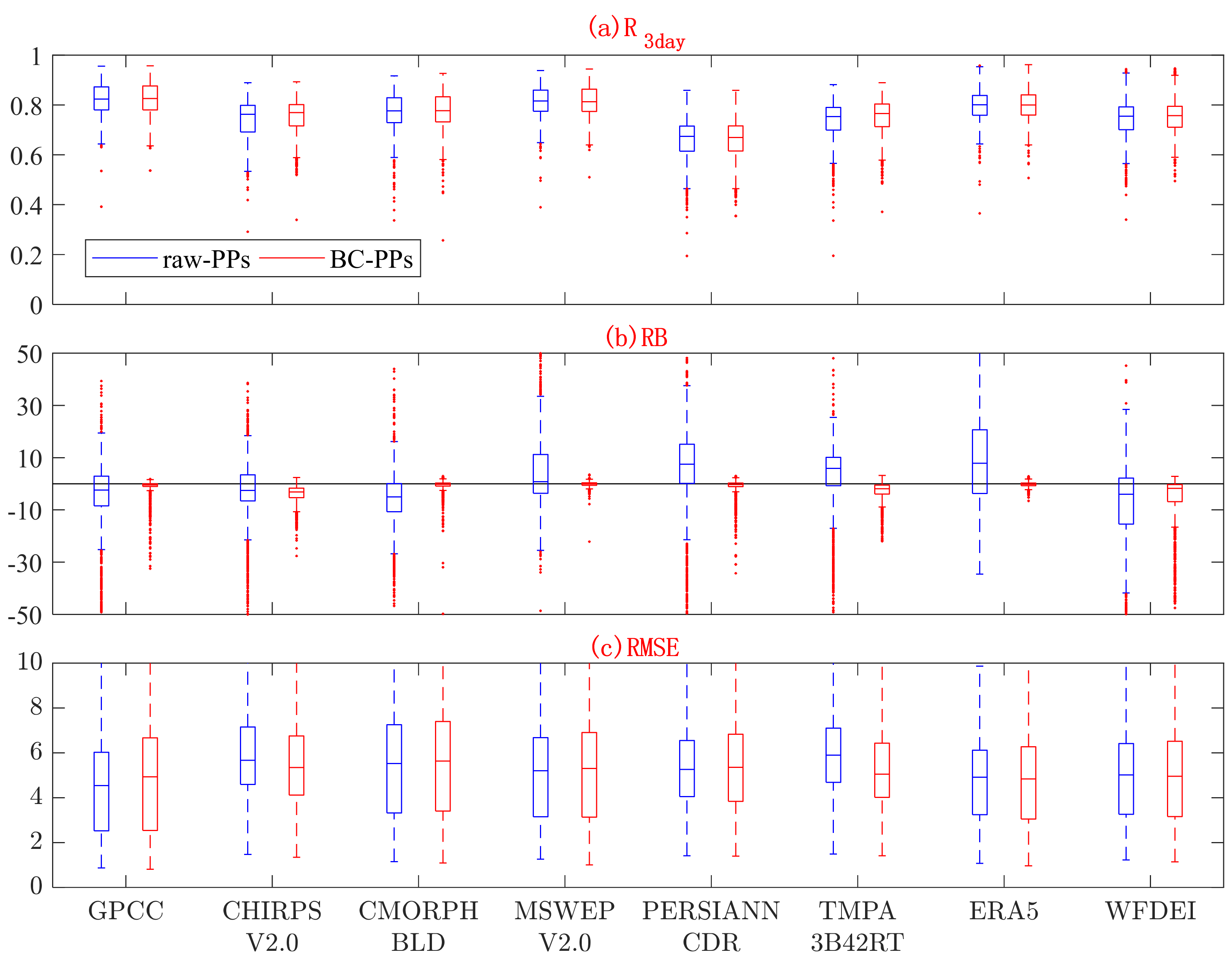

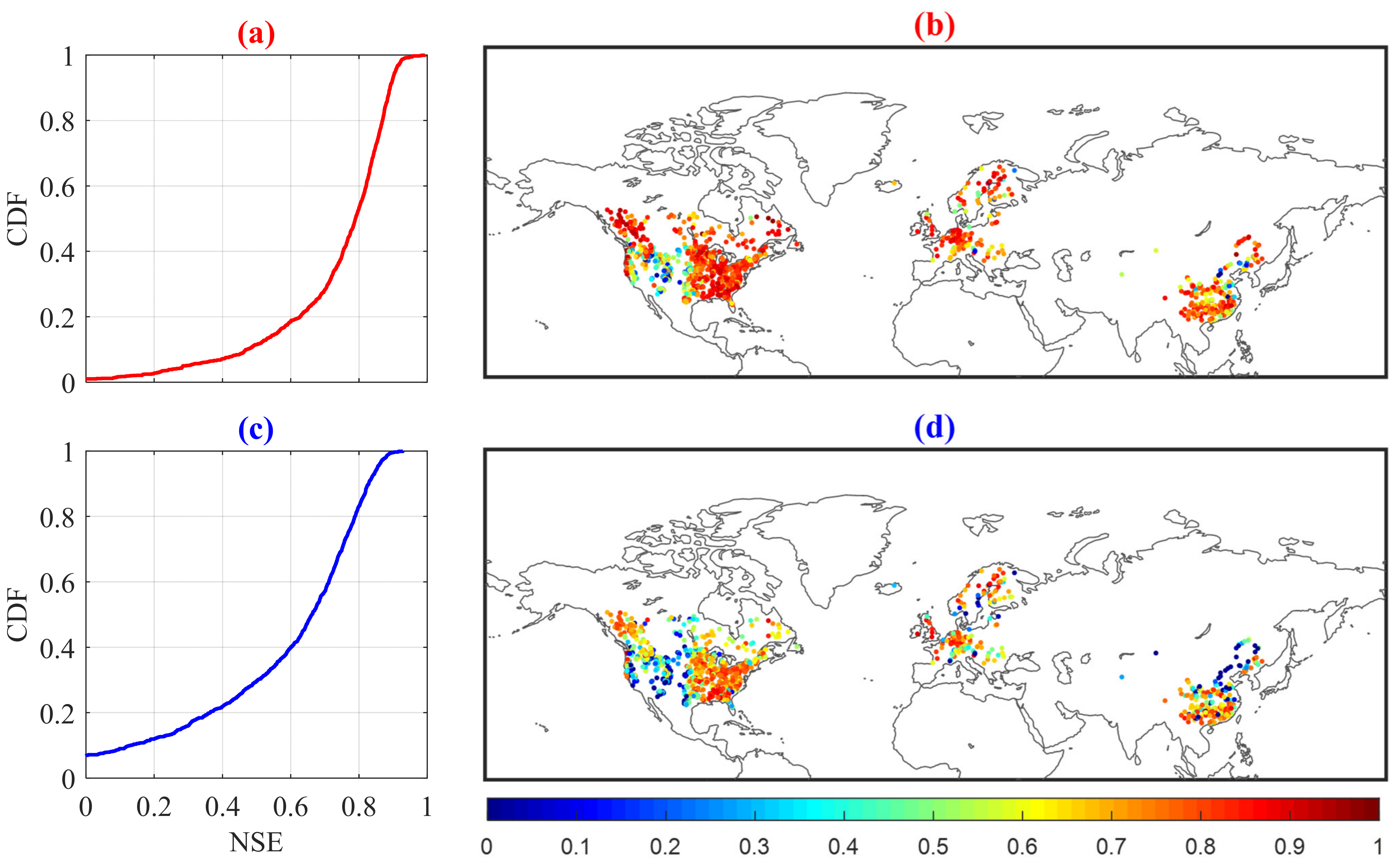
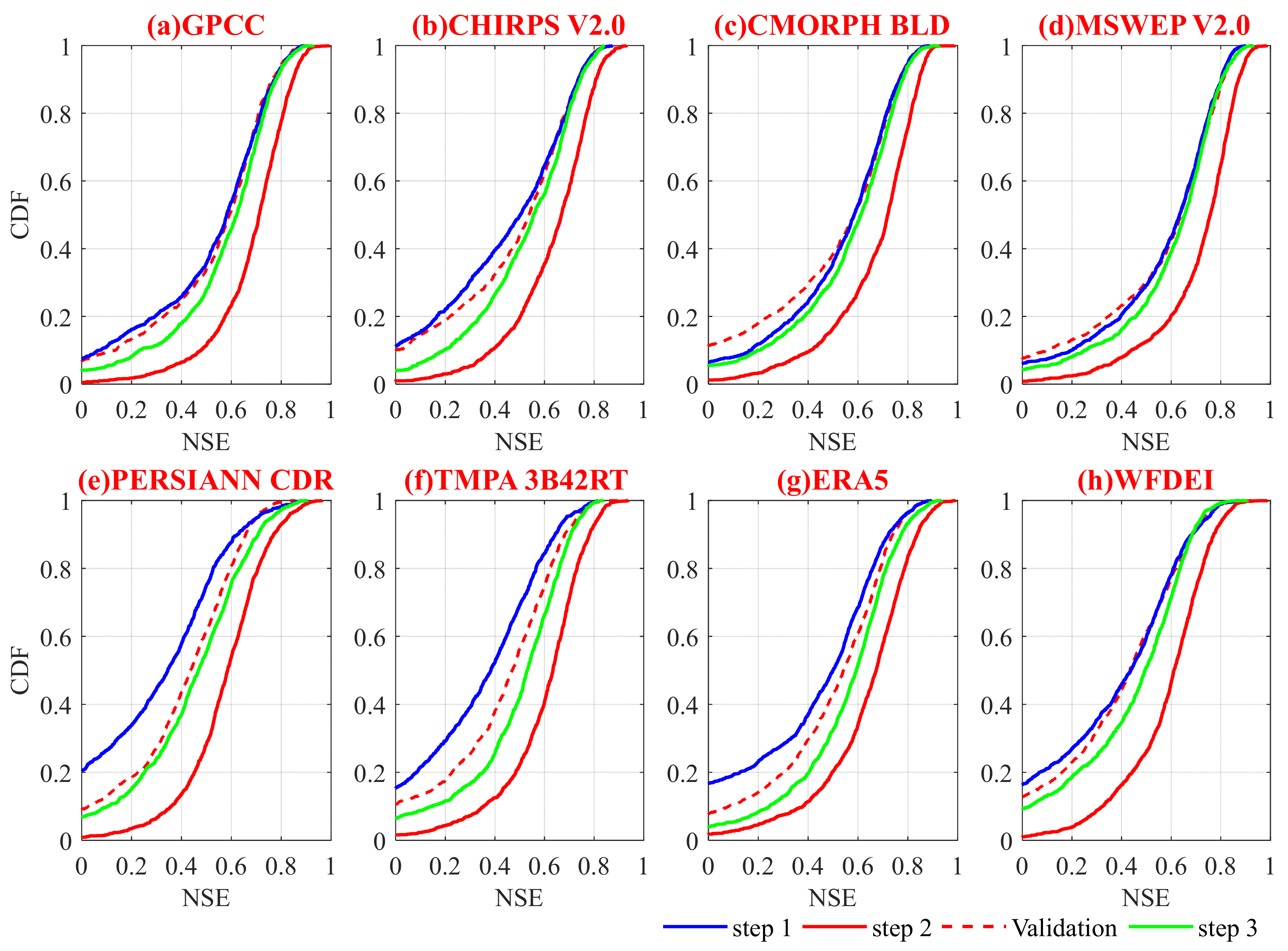
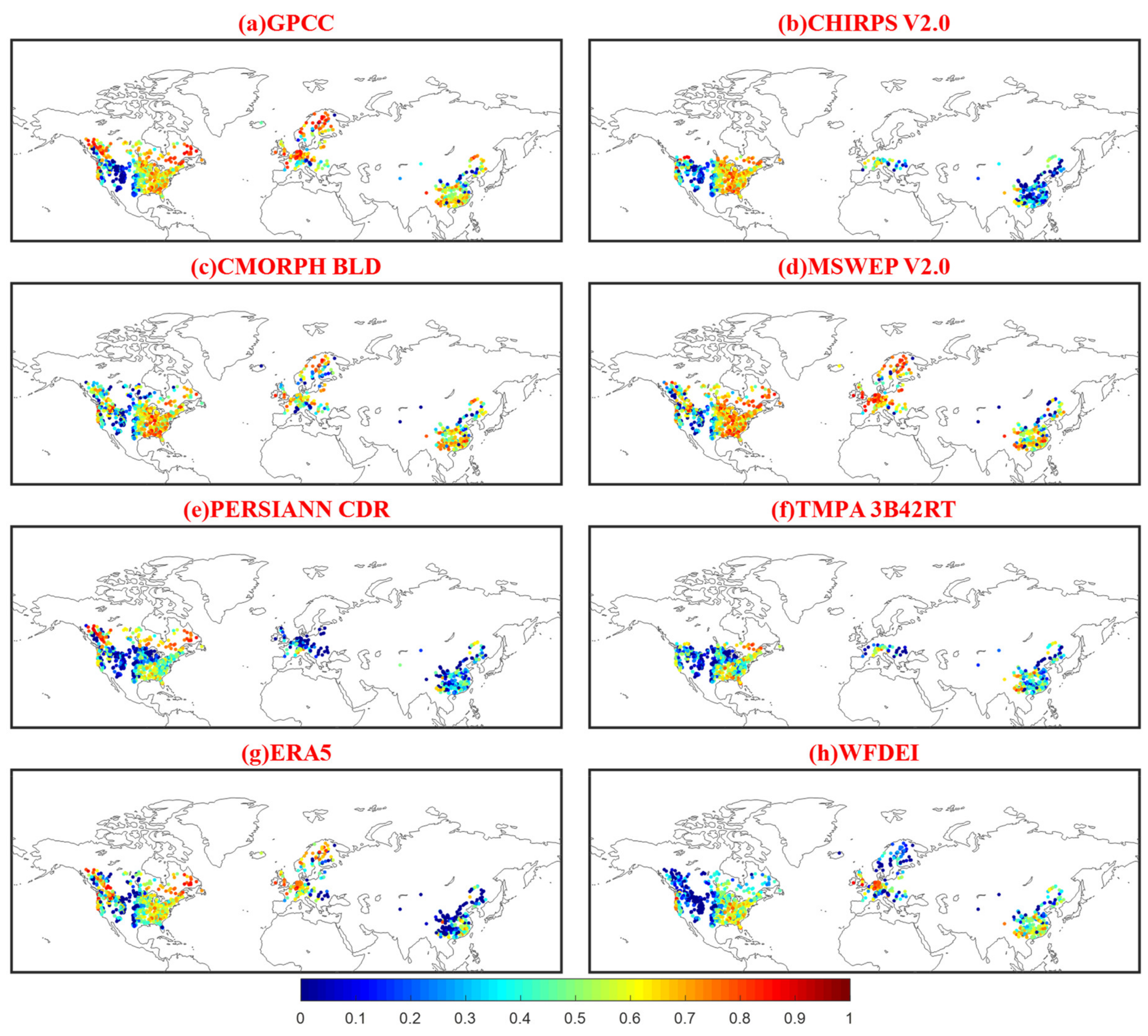


| Type | Name (Details) | Category | Temporal/Spatial Resolution | Temporal Coverage | Reference or Link |
|---|---|---|---|---|---|
| Global Precipitation Datasets | GPCC (Global Precipitation Climatology Centre) | G | Daily/global 0.5° | 1982–2016 | Schneider, Fuchs [40] |
| CHIRPS V2.0 (Climate-Hazards Group Infrared Precipitation V2.0) | S/R/G | Daily/50N-50S 0.25° | 1981–now | Peterson, Funk [41] | |
| CMORPH BLD (Climate Prediction Center Morphing Technique, Gauge Blended dataset) | S/G | 30 min/global 0.25° | 1998–now | Joyce, Janowiak [42] | |
| PERSIANN CDR (Precipitation Estimation from Remotely Sensed Information Using Artificial Neural Networks dataset, Climate Data Record) | S/G | Daily/60N-60S 0.25° | 2003–now | Ashouri, Hsu [43] | |
| TMPA 3B42RT (Tropical Rainfall Measuring Mission multi-satellite Precipitation Analysis 3B42RT) | S/G | 3-hourly/50N-50S 0.25° | 1998–now | Huffman, Bolvin [33] | |
| MSWEP V2.0 (Multi-Source Weighted-Ensemble Precipitation V2.0) | S/R/G | 3-hourly/global 0.25° | 1979–now | Beck, Van Dijk [19] | |
| ERA5 (European Center for Medium-range Weather Forecast Reanalysis 5) | R | Hourly/global 0.5° | 1979–now | Hersbach, Bell [20] | |
| WFDEI (WATCH Forcing Data (WFD) methodology applied to ERA-Interim Data) | R/G | 3-hourly/global 0.5° | 1979–2016 | Weedon, Balsamo [44] | |
| Gauge-observed Precipitation, Temperature | CGRD/CGTD (China Ground Rainfall/temperature Daily Value 0.5°×0.5° Lattice Dataset) | — | Daily/0.5° | 1961–2015 | http://data.cma.cn, accessed on 16 July 2021 |
| E-obs (European high-resolution gridded dataset) | — | Daily/0.5° | 1950–2017 | Haylock, Hofstra [45] | |
| CANOPEX (Canadian model parameter experiment database); Santa Clara database | — | Daily/catchment averaged | — | Arsenault, Bazile [46]; Maurer, Wood [47] | |
| Gridded Potential Evaporation Data | GLEAM (Global Land Evaporation Amsterdam Model) | — | Daily/global 0.5° | 1980–2018 | Martens, Miralles [48] |
| Observed Streamflow | Streamflow-gauging stations in China | — | Daily/station | — | — |
| GRDC (Global Runoff Data Centre) | — | Daily/station | — | http://grdc.bafg.de, accessed on 16 July 2021 | |
| CANOPEX; USGS (United States Geological Survey database) | — | Daily/station | — | Arsenault, Bazile [46]; Falcone, Carlisle [49] |
| GPCC | CHIRPSV2.0 | CMORPH BLD | MSWEPV2.0 | PERSIANNCDR | TMPA 3B42RT | ERA5 | WFDEI | |
|---|---|---|---|---|---|---|---|---|
| Step 1 | 0.58 | 0.50 | 0.59 | 0.63 | 0.35 | 0.38 | 0.50 | 0.44 |
| Step 2 | 0.71 | 0.67 | 0.72 | 0.76 | 0.58 | 0.63 | 0.67 | 0.61 |
| Step 3 | 0.62 | 0.56 | 0.61 | 0.65 | 0.47 | 0.53 | 0.59 | 0.49 |
| Step 2’ | 0.13 | 0.17 | 0.13 | 0.12 | 0.24 | 0.25 | 0.17 | 0.17 |
| Step 3’ | 0.04 | 0.05 | 0.03 | 0.02 | 0.12 | 0.15 | 0.09 | 0.06 |
Publisher’s Note: MDPI stays neutral with regard to jurisdictional claims in published maps and institutional affiliations. |
© 2021 by the authors. Licensee MDPI, Basel, Switzerland. This article is an open access article distributed under the terms and conditions of the Creative Commons Attribution (CC BY) license (https://creativecommons.org/licenses/by/4.0/).
Share and Cite
Xiang, Y.; Chen, J.; Li, L.; Peng, T.; Yin, Z. Evaluation of Eight Global Precipitation Datasets in Hydrological Modeling. Remote Sens. 2021, 13, 2831. https://0-doi-org.brum.beds.ac.uk/10.3390/rs13142831
Xiang Y, Chen J, Li L, Peng T, Yin Z. Evaluation of Eight Global Precipitation Datasets in Hydrological Modeling. Remote Sensing. 2021; 13(14):2831. https://0-doi-org.brum.beds.ac.uk/10.3390/rs13142831
Chicago/Turabian StyleXiang, Yiheng, Jie Chen, Lu Li, Tao Peng, and Zhiyuan Yin. 2021. "Evaluation of Eight Global Precipitation Datasets in Hydrological Modeling" Remote Sensing 13, no. 14: 2831. https://0-doi-org.brum.beds.ac.uk/10.3390/rs13142831







